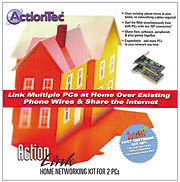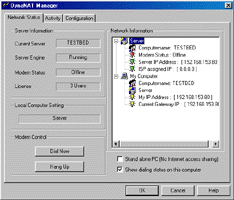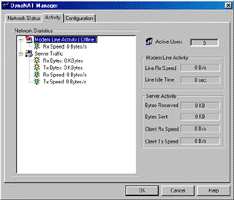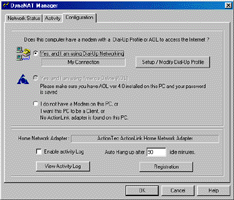
Original Link: https://www.anandtech.com/show/314
ActionTec ActionLink Home Networking Kit
by Mike Andrawes on June 8, 1999 11:54 PM EST- Posted in
- Networking
|
Quick Look |
||
|
ActionTec ActionLink |
The Good | |
|
|
+ Uses existing
phone line |
|
| The Bad | ||
|
- Only 1Mbps bandwidth |
||
With computer prices dipping well below $1000, the number of PC's in the home is rising rapidly. Sometimes it's a matter of having a second computer for the kids. Or maybe you just have an old computer that is still enough to browse the web and send e-mail. In either of these situations, it would be extremely convenient to be able to share files, printers, or an internet connection. Or maybe none of that matters, but you just want to be able to get together with friends for some multiplayer deathmatch ;) Obviously, what we need here is a network.
Up until recently, a network in the home was simply not very feasible. Ethernet cards cost too much, hubs cost even more, and then there was the problem of running all the wiring. Times have changed greatly - ethernet cards are cheap and hubs are cheap, but the wiring issue still remains. Nobody wants to run new cables through their house. Fortunately, a variety of new technologies are emerging that allow in home networks without any new wiring. The two most popular options are wireless technologies and those that run "on top" of existing wires.
ActionTec's new ActionLink networking kit uses the latter method and runs over standard copper phone wire that should already be in place in every home. The technology used is based on the HomePNA (Home Phoneline Networking Alliance) standard that allows for interoperability between different manufacturers devices.
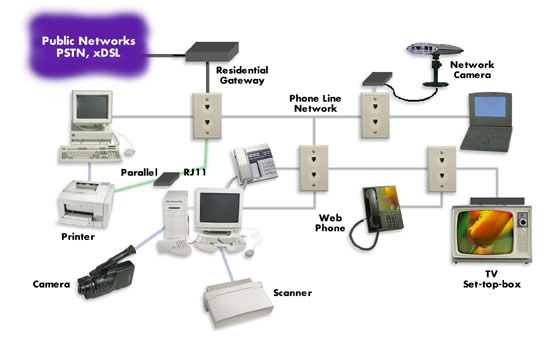
Copyright 1999 AMD
HomePNA runs on top of existing lines, without interfering with their normal operation, by sending its signals at a much higher frequency that is normally not used. This is similar to xDSL technology, but rest assured that HomePNA uses a different frequency than xDSL and will thus not interfere with its operation. Up to 25 computers can be used in such a network without the use of splitters, hubs, terminators, or any other devices.
Specifications
- AMD PCnet-Home controller
- 32-bit PCI bus master interface
- Data Transmission Speed: 1Mbps
- RJ-11 network interface
- 500 feet maximum transmission distance between all nodes
- Drivers for Windows 9x and NT 4.0
- 5 year warranty
- Software bundle - DynaNAT Internet Sharing, Star Control 3 Full Version, miscellaneous Accolade game demos
Hardware
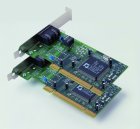 The
ActionLink package includes two HomePNA NIC's, internet sharing software, a
detailed manual, a driver CD, and a CD filled with games and game demos. All
this comes in at under $100, and additional NIC's for adding more computers
are under $50.
The
ActionLink package includes two HomePNA NIC's, internet sharing software, a
detailed manual, a driver CD, and a CD filled with games and game demos. All
this comes in at under $100, and additional NIC's for adding more computers
are under $50.
The NIC's are based on AMD's PCnet-Home chip, a chip that is based on one of AMD's fast ethernet chips and features 32-bit PCI bus mastering support. The PCnet-Home version supports both regular 10Base-T or HomePNA networks. The ActionLink cards, however, are designed with only HomePNA in mind, and do not feature a 10Base-T port.
The HomePNA standard currently provides for 1Mbps transfer rates, although they are working on a backwards compatible specification with a target bandwidth of 10 Mbps. Unfortunately, 1 Mbps is just 10% the bandwidth of a standard 10Base-T network, and 1% of a 100Base-T network. While that may seem incredibly slow, it is sufficient for sharing most basic applications. If you have xDSL or a cable modem capable of over 1Mbps transfers, all machines besides the one physically connected to the xDSL/cable modem will feel the performance hit during heavy traffic.
The PCnet-Home is also ACPI compliant for enhanced plug-n-play and power management support under an ACPI compliant OS such as Windows 98 or 2000. A wake on LAN header is not included on the card.
There are two phone jacks on the card, one for connecting to pre existing phone wiring, and the other that acts as a pass through for a phone or modem. It also would have been nice to have some status lights on the back of the cards. These are included on most ethernet NIC's and can come in quite handy when trying to diagnose a network problem.
Installation
The hardware portion of the installation is extremely easy - just open your case, locate a free PCI slot and plug it in. Then, run a standard phone cable from the card to a phone jack, and plug your phone or modem into the pass through jack on the card. Repeat for the other systems in the network and your done with the hardware installation. It doesn't get any simpler than this!
As a PCI card, plug-n-play will most likely configure the card correctly in most situations. Just like any standard NIC, the ActionLink cards require a single IRQ. Windows 9x detected the card and asked for drivers. Simply pointing to the CD for drivers kick starts the rest of the software installation. After Windows finishes its job with the drivers, the ActionLink installation program pops up to configure the network. It walks you through assigning network names and then allows you to select drives and printers for sharing.
The internet sharing software, DynaNAT, must be installed separately. It's a simple matter of clicking on the install file. The install program guides you through step by step and keeps it simple by asking for only one or two pieces of information at a time. The software only functions with an ActionTec card installed and selected as the network adapter for sharing.
The extremely detailed manual actually recommends that no other network cards be present in the system with the ActionLink. While this does simplify things somewhat, it is not absolutely necessary. The manual does an excellent job of guiding the user through every step involved in the hardware and software installations. Screenshots of just about everything you will see under Windows 9x or NT 4.0 are given along with the step by step instructions. A troubleshooting guide takes you through potential solutions for some of the most common problems users will encounter.
Software
The included DynaNAT software is actually based on a limited version of Sygate Internet Connection Management Software and works just like it. It's even referred to as "DynaSygate with DynaNAT technology" on the ActionLink box. NAT stands for Network Address Translation and is the technology widely used in hardware based routers. The software acts as a DHCP server to automatically assign IP addresses to client machines. Configuration is pretty much automatic, but the manual guides you through step by step here as well. Most automatic settings can be overridden, such as the ability to assign specific IP addresses to specific client machines. A diagnostics program is included to help sort things out if trouble does arise.
DynaNAT can be configured to auto dial the modem when any computer on the network tries to access the internet. The included DynaNAT manager provides server status, network status, and network activity for the internet connection. An activity log can be kept to monitor what sites are being browsed and help keep an on eye on those pesky kids ;) Control of the connection can be performed from any client PC or the server. Unfortunately, as the screenshots show, you only get a 3 users license (a total of four users can access the internet from one connection).
If AOL is your ISP, internet sharing becomes somewhat more complex. The problem lies in the fact that AOL only allows one user from an account to be logged on at a time. Since AOL is the ISP, the account will be logged on to from the server machine in the network. Nobody else will then be able to log onto the same AOL account. Others on the network will still be able to browse the web, play games, etc. - just not log onto AOL. AOL version 4.0 is also required for compatibility with DynaNAT and you'll need to tell AOL to save your password. Don't worry, it's all covered in detail in the manual if the situation ever arises.
As a NAT based program, it is actually not necessary to set up any software on the client machines and works transparently with almost any application, including web browsers, FTP clients, Quake 1/2/3, ICQ, IRC, AOL Instant Messenger, and Roger Wilco. This is unlike a proxy setup where each program would need to be configured to recognize and use the proxy server.
If the software is installed on each machine on the network, it will automatically select a machine to dial the internet connection based on which are powered on and have modems. If all machines have modems, this allows for seamless connection to the internet regardless of which machines are powered on and whether anyone on the network is already connected to the internet.
With a modem, no degradation in performance was noticed on any of the networked machines. Of course total bandwidth is still limited to what the modem can do, but each machine has the potential to attain full modem speeds if no other machines on the network are using up the bandwidth. The DynaNAT software has very little CPU overhead on the server machine - approximately 4% on a Celeron 300A with 64MB SDRAM and a 56kbps modem downloading full speed.
The software also works with xDSL, cable, and satellite connections. Note that a standard NIC dedicated to connecting to these services is usually required in addition to your ActionLink card. This will vary with the exact configuration of the connection. If you have any internet connection with 1Mbps or more bandwidth, you may feel some slow down on client machines since HomePNA only supports 1Mbps. Note that this is not a limitation of the DynaNAT software in anyway.
DynaNAT is designed to only function if the machine with the internet connection is configured to share the connection through an ActionTec NIC.
With so much focus on multiplayer gaming these days, its no surprise that ActionTec sees this as one of the key features of their kit, especially since its targeted at the home. As such, a full copy of Star Control 3, along with demos of various multiplayer Accolade games, are included in the box.
Performance
 Performance
was exactly as advertised on the side of the box - approximately 1Mbps of bandwidth
is available for any purpose. That may not seem like much, but it is enough
for basic network purposes - playing games, sharing printers, sharing small
files, internet sharing (once again, unless you have over 1Mbps bandwidth),
etc. It handled an intense Quake 3 deathmatch without any problems or noticeable
lag.
Performance
was exactly as advertised on the side of the box - approximately 1Mbps of bandwidth
is available for any purpose. That may not seem like much, but it is enough
for basic network purposes - playing games, sharing printers, sharing small
files, internet sharing (once again, unless you have over 1Mbps bandwidth),
etc. It handled an intense Quake 3 deathmatch without any problems or noticeable
lag.
Unfortunately, for large file transfers, 1Mbps is pretty slow - that 175MB transfer took about 26 minutes to complete. Remember, that 1 Megabit/s translates to 125 kilobytes/s since there are 8 bits in a byte. Not completely unreasonable, but a standard 10Base-T ethernet solution would take as little as one tenth the time. Fast ethernet (100Base-T ethernet) could cut that down by a factor of a hundred (in theory anyway).
To make matters even worse, there is only 1Mbps bandwidth available across the whole network. So two full speed file transfers will half the transfer rate. Of course three transfers would cut the transfer rate by a factor of three and so on and so forth. As such, the network begins to quickly bog down as soon as multiple users start using the network heavily. So don't expect to transfer files and still have seamless network gaming. This is more a limitation of the HomePNA standard than the ActionLink Home Network Kit.
The AMD PCnet-Home chip used on these cards is a busmastering device that promises low CPU utilization, and comes through in the real world with under 1% CPU utilization during a 175MB file transfer.
Other Notes
Unlike many other products in this market segment, the ActionLink is fully compatible with Windows NT 4.0, as is the included internet sharing software, DynaNAT. Windows 2000 drivers are already functional and will be available upon the release of Windows 2000 from Microsoft.
There are rumors of a hack to get cards based on the AMD PCnet-Home chipset, such as the ActionLink, to work under Linux. If there is a hack out there now, it probably means it will be official soon enough. This comes as no surprise since network cards based on AMD chipsets have generally enjoyed good support under Linux.
The manual recommends against having another NIC in the system with the ActionLink card, going as far as to tell you not to do such a thing. Well, it is possible, and is even required for most xDSL, cable, or satellite services. However, if you simply want to connect your HomePNA network to an existing ethernet, you are pretty much out of luck. A machine with a 10Base-T NIC and a HomePNA NIC will see both parts of the network, but each network will otherwise remain isolated.
Conclusion
|
Quick Look |
||
|
ActionTec ActionLink |
The Good | |
|
|
+ Uses existing
phone line |
|
| The Bad | ||
|
- Only 1Mbps bandwidth |
||
When it's simply not possible to run new wiring for ethernet, the ActionLink Home Networking Kit is an excellent solution for basic networking at home. Everything works as promised and the manual should serve as a model for other manufacturers. However, 1Mbps of bandwidth is somewhat slow. So if ethernet is a possibility, go for it and up to 100 times faster performance - it's about the same price too. Later this year, the second generation of HomePNA products should arrive with a target of 10Mbps bandwidth. For now however, HomePNA is an incredibly easy setup and fast enough for most applications. ActionTec's ActionLink package appears to be one of the best executed HomePNA products available right now.

